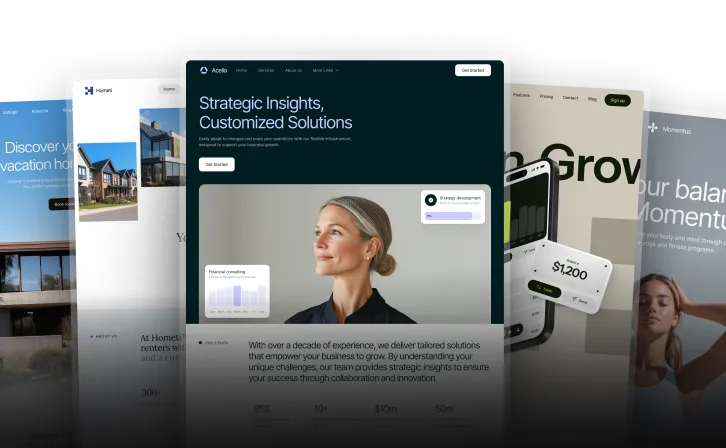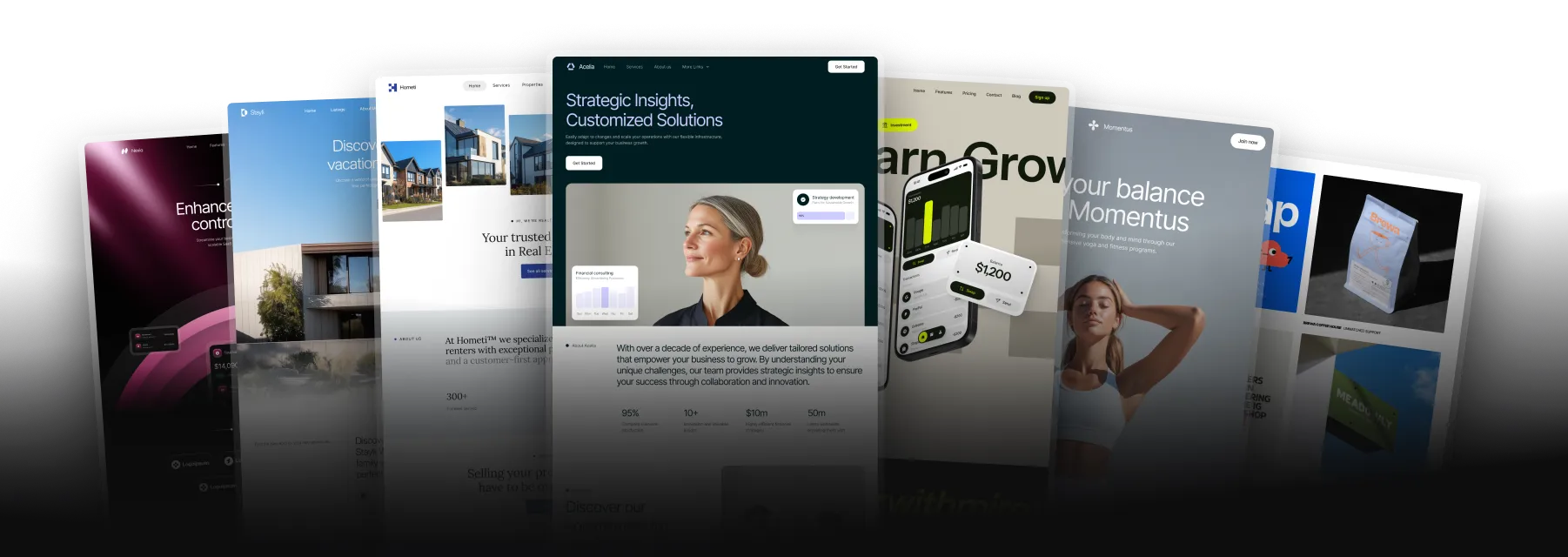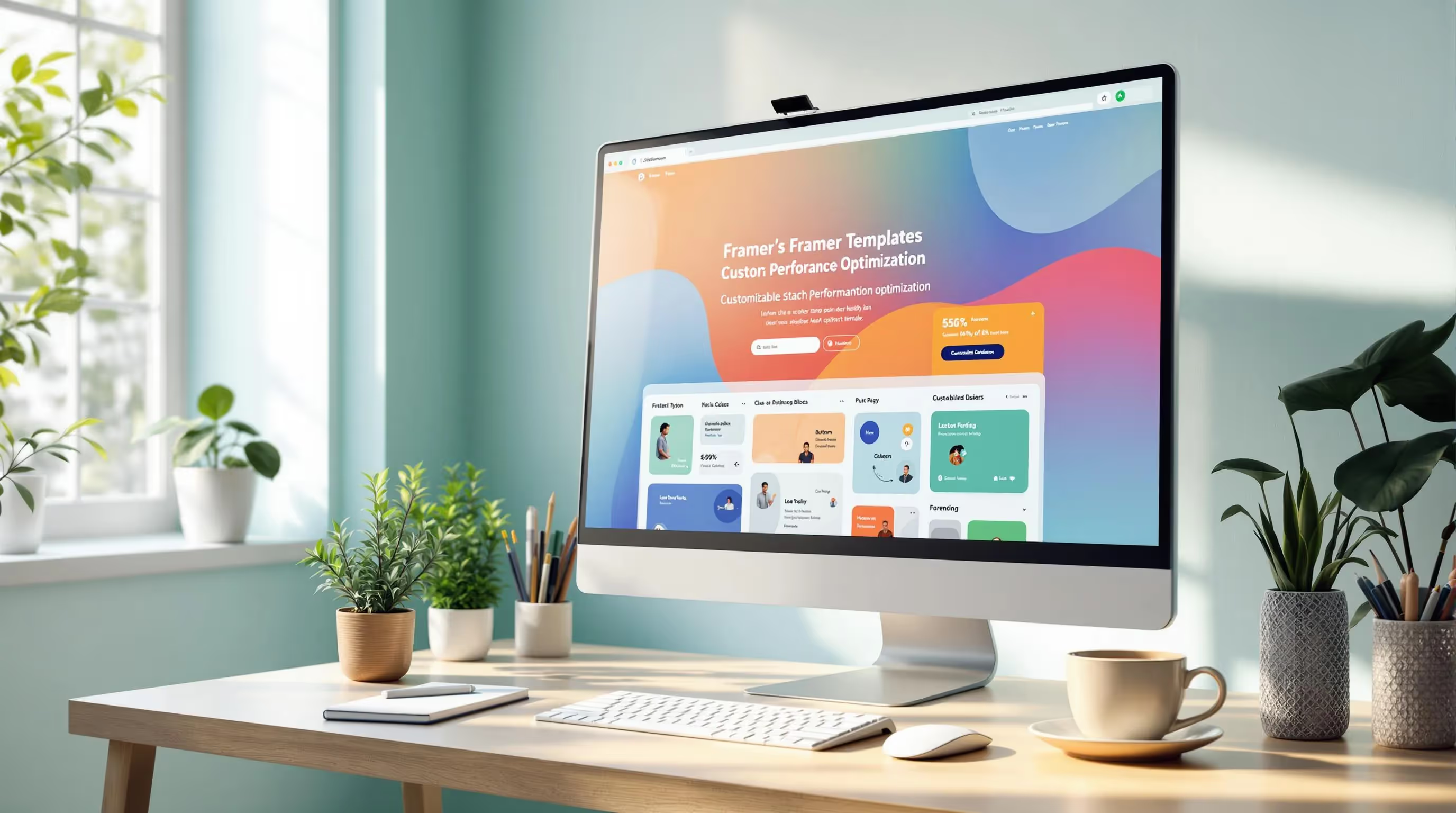Framer Templates: The Definitive Handbook
Unlock all templates




Framer templates make website creation fast and simple. These pre-designed layouts are fully customizable and ideal for various website types, such as marketing sites, blogs, portfolios, and e-commerce. They save time, enhance performance, and support modern design trends like accessibility and responsiveness. Here's what you need to know:
- Why Use Them: Build professional websites quickly with clean designs and interactive features.
- Best Uses: Perfect for SaaS, e-commerce, informational sites, and blogs.
- Top Features: SEO-ready, mobile-friendly, CMS support, and customizable layouts.
- Customization: Use Framer's drag-and-drop tools to edit typography, colors, layouts, and animations without coding.
- Performance Tips: Optimize images, enable server-side rendering, and improve mobile performance for faster load times.
- SEO & Accessibility: Add clear headings, alt text, and semantic tags to boost search rankings and usability.
Quick Comparison:
| Purpose | Key Features | Example Template | Price |
|---|---|---|---|
| SaaS/AI | Feature pages, pricing tables, CMS | ClayAI | $49 |
| E-commerce | Product galleries, shopping cart | Commerce | Varies |
| Portfolio | Image galleries, contact forms | Imagen Pro | $49 |
| Wellness Businesses | Booking features, service pages | Calmy | $79 |
Framer templates combine ease of use with powerful tools to help you launch professional websites in no time. Whether you're building a personal portfolio or a SaaS landing page, these templates offer flexibility and performance.
How to use a Framer Template

How to Pick a Framer Template
Define Your Website Purpose
Start by identifying the main goal of your website. Different industries have different needs, so you'll want a Framer template that aligns with your purpose.
For example, SaaS companies often require pages like Features, Pricing, and Contact. You might also need extras such as a Blog, Changelog, or User Agreement to support your content strategy and user engagement. Make sure the template is compatible with your needs and performs efficiently.
Here’s a quick breakdown:
| Purpose | Key Features | Example Template |
|---|---|---|
| SaaS/AI | Feature comparison, pricing tables, case studies | ClayAI ($49) with CMS integration |
| E-commerce | Product galleries, shopping cart, Shopify integration | Commerce with Shopify integration |
| Portfolio | Image galleries, project showcases, contact forms | Imagen Pro ($49) with CMS support |
Once you've narrowed down your options, test the template's performance and responsiveness to ensure it meets high standards.
Check Template Quality
The quality of your template plays a major role in your website's performance. Research shows that websites loading in just 1 second can convert visitors 5× better than those taking 10 seconds.
To evaluate a template's quality, use tools like Google Lighthouse, Chrome DevTools, or live device previews. These can help you spot issues with loading speed, responsiveness, and overall usability.
Template Types by Industry
Your industry can also influence which template is the best fit. Some templates are designed with specific features tailored to particular fields.
For instance, the Miros template ($129) is ideal for SaaS companies, offering customizable layouts and sections for showcasing software solutions. Wellness businesses might prefer the Calmy template ($79), which includes dedicated areas for services and bookings.
Here’s a real-world example: Meghan Arthur, a client of Bryn Taylor, successfully used a minimal portfolio template. Meghan shared:
"The Framer community page helped when I had an error (Framer fixed it quickly) and Bryn was very responsive with any questions she had."
For AI-powered startups, the Horizon template is a standout option. It’s designed to highlight features like real-time market trends and user queries, making it a great choice for showcasing AI capabilities while maintaining excellent performance.
Making Templates Your Own
Framer Basics
Framer's drag-and-drop interface makes customizing templates simple and code-free, much like Figma. You'll find the main tools for customization in two key areas:
- Assets Tab: Manage colors, typography, and other design elements here.
- Right-Hand Panel: Adjust component properties and layout settings.
These tools are your foundation for making changes. To avoid impacting your live site, duplicate your template before experimenting.
Core Design Changes
To start customizing, get familiar with Framer's component system, especially its 'Primary Variant' feature.
| Design Element | How to Customize | Tip |
|---|---|---|
| Typography | Use the Web fonts tab or upload custom fonts | Opt for Google Fonts for faster loading. |
| Colors | Edit in the Assets tab | Stick to a consistent color scheme. |
| Layout | Adjust properties in the Right-Hand Panel | Keep spacing uniform across elements. |
| Components | Double-click to edit | Focus on primary variants first. |
"Framer has made web design easier than ever, allowing designers to build stunning, interactive websites without complex code".
Once these basics are in place, it's time to bring your brand to life.
Adding Your Brand Elements
After finalizing the core design, incorporate your brand identity to make the site truly yours. Studies show that interactive web design can boost user retention by 60% compared to static sites.
Here’s how to personalize your site:
- Upload custom fonts (.woff2) via the Web tab - Google Fonts are a great choice.
- Update primary and secondary colors in the Assets tab to match your brand.
- Add dynamic features like hover effects to enhance interactivity.
- Nest components to create more complex layouts.
This method works - 94% of web designers believe that a well-thought-out interface builds user trust.
sbb-itb-fdf3c56
Speed and Performance Tips
Make Pages Load Faster
A fast-loading website is key to keeping users engaged. Research shows that even a one-second delay in mobile page load time can cut conversions by up to 20%. Framer includes built-in tools to improve speed, but you can take it further with these tips:
| Area | Best Practice | Benefit |
|---|---|---|
| Images | Use WebP or AVIF formats | Cuts file size by 25–34% |
| Effects | Keep blur values below 10 | Speeds up rendering |
| Scripts | Add async or defer attributes |
Optimizes load order |
| Videos | Use YouTube or Vimeo embeds | Reduces server load |
For an extra boost, turn on Framer's Server-Side Rendering (SSR) in your project settings. Luca Da Corte, a Certified Framer Expert, emphasizes:
"Ensuring your project is optimized is probably the most important thing you can do on this list".
Next, focus on mobile performance to capture your audience effectively.
Mobile Display Updates
With mobile devices accounting for over 61.85% of global website traffic, your site must perform well on smaller screens. Aim to meet these mobile performance benchmarks:
- Largest Contentful Paint (LCP): Under 2.5 seconds
- Interaction to Next Paint (INP): Under 0.2 seconds
- Cumulative Layout Shift (CLS): Less than 0.1
To hit these targets, apply these mobile-specific tweaks:
- Set image resolution to "Auto" for device-specific optimization.
- Add cover images for videos to improve initial load times.
- Minimize JavaScript-heavy elements above the fold.
- Simplify animations to avoid slowing down mobile performance.
SEO and Access Updates
Optimizing for SEO and accessibility ensures your site reaches a broader audience. Framer automatically generates sitemap.xml and robots.txt files, but you can enhance your template further:
"Framer optimizes your pages for excellent SEO by default, offering full control over SEO markup, indexing rules, redirects, and more."
- Framer Help
Here’s how to improve SEO and accessibility:
-
SEO Basics
Use clear H1 headings and descriptive meta titles. Add structured data with JSON-LD to help search engines understand your content better. -
Accessibility Features
Leverage Framer's accessibility tools to:- Add descriptive alt text for images
- Set custom tab orders for smooth navigation
- Enable reduced motion for animations
-
Use proper semantic tags like
<article>,<footer>, and<header>.
Keep your site in top shape by regularly testing with tools like Google Lighthouse and PageSpeed Insights.
Pro-Level Template Skills
Adding Custom Code
Adding custom code can expand your Framer template's capabilities. For code that applies to your entire site, use the project settings. For code specific to individual pages, work within the page settings.
"Adding custom code is a great way to extend the functionality of your Framer site. However, it is important to note that adding custom code can also make your site more difficult to maintain."
Here’s a quick breakdown of how to approach different types of code:
| Code Type | Best Practice | Implementation |
|---|---|---|
| Global Scripts | Add through project settings | Place in the header or footer |
| Page-Specific | Use page-level settings | Limit to single pages |
| Components | Build reusable elements | Modular and scalable |
Once your custom code is in place, you can take things further by introducing interactive animations.
Building Animations
Animations in Framer deliver smooth, high-performance interactions at 60 FPS. To get the most out of them, follow these tips:
-
Start with User Triggers
Create animations that respond to user actions like hovers, clicks, or scrolling. These triggers make your site feel more interactive. -
Refine Motion Design
Use tools like Magic Motion for seamless transitions or spring physics for a natural, lifelike feel. -
Prioritize Accessibility
Include settings that let users reduce motion if they are sensitive to animations. This ensures your site remains welcoming to everyone.
With these techniques, your animations can transform your site into an engaging experience. Next, let’s look at managing content effectively with Framer CMS.
Using Framer CMS
Framer CMS helps you manage dynamic content with ease - perfect for blogs, product catalogs, or news updates. To get started, organize your CMS with clear field types:
| Field Type | Best Use Case | Example |
|---|---|---|
| Text | Titles, descriptions | Product names |
| Rich Text | Formatted content | Blog posts |
| Images | Visual elements | Product photos |
| URLs | External links | Resource links |
| Dates | Time-based content | Event schedules |
To make the most of your CMS setup:
-
Plan Your Structure
Design consistent fields to handle your growing content efficiently. -
Optimize for Search
Add SEO-friendly details like meta descriptions, clear page titles, and alt text for images. -
Leverage Dynamic Features
Use tools like the "Repeat" feature to display multiple items from a collection and apply conditional styles to customize content based on data.
Framer CMS streamlines content management, making it simpler to build and maintain dynamic, data-driven websites.
Next Steps with Framer Templates
Main Points Summary
Once you've learned how to select, customize, and fine-tune templates, putting that knowledge into action is key. Framer templates help you quickly create professional websites by focusing on smart customization and performance tweaks.
| Success Factor | Impact | Implementation |
|---|---|---|
| Speed Optimization | Boosts branded clicks by 65% | Use image compression and Performance Mode |
| Development Time | Pages ready 10x faster | Leverage built-in CMS and template tools |
| Visitor Capacity | Handles up to 200,000 visitors/month | Activate Pro plan optimization features |
"Templates in Framer are duplicates of projects other people have made. Open the project, edit the content and attach a site plan to launch your website." - Framer Academy
Now that you know the benefits, here’s how to get your site up and running.
Getting Started
Here’s how to begin:
-
Choose a Plan
The Basic plan costs $15/month, supporting up to 10,000 monthly visitors and 150 pages. It's a good fit for small businesses or personal websites. -
Pick the Right Template
Explore the Framer Marketplace for templates that offer:- Built-in responsiveness
- Quick loading times
- SEO-friendly layouts
- CMS integration
-
Follow a Performance Checklist
- Use modern image formats like WebP or AVIF
- Activate Performance Mode
- Apply SEO best practices
- Add accurate meta descriptions
Real-world examples back these strategies: Dribbble achieved 10x faster landing page creation after adopting Framer, while Contra saw a 65% jump in branded clicks by optimizing their careers page.
Related Blog Posts
Recommended posts
Unlock all templates







